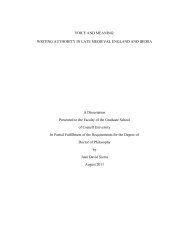Briana Anderson - Cornell University
Briana Anderson - Cornell University
Briana Anderson - Cornell University
Create successful ePaper yourself
Turn your PDF publications into a flip-book with our unique Google optimized e-Paper software.
69<br />
study. These hypotheses predicted that attractiveness would be positively correlated<br />
with perceptions of overall credibility, including the measures of endorser<br />
trustworthiness and expertise. These results could have been a function of the clothing<br />
styles or perceived age of the endorsers, as mentioned in the limitations section, but<br />
this thesis posits that attractiveness of endorser has different effects depending on the<br />
type of message. This calls into question whether the Ohanian (1990) scale is<br />
appropriate to use in every endorser study.<br />
Ohanian’s (1990) endorser credibility scale includes attractiveness as one of<br />
the underlying constructs of the scale. Ohanian (1990) justifies including<br />
attractiveness as a construct based on Joseph’s (1982) review of attractiveness in<br />
advertising and related disciplines that suggests that attractive communicators are<br />
consistently liked more and have a positive impact on products. Using attractiveness<br />
as a construct for endorser credibility in this study was inappropriate for two reasons:<br />
1) because attractiveness was manipulated as part of the independent conditions and 2)<br />
this is a study focused on the selling of an idea (social responsibility of a company)<br />
not a consumer product.<br />
The results of this study indicate that in a public relations/ social responsibility<br />
campaign (versus product advertising and marketing), the physical attractiveness of<br />
endorser behaves differently. In fact, the data supported an opposite finding of what<br />
would typically be expected of attractiveness, that is, that it leads to lower levels of<br />
perceived expertise and trustworthiness rather than hiher. One possible explanation is<br />
that perceptions of an endorser in public relations (or the selling of ideas) may be<br />
based on different standards than those in marketing and advertising. Specifically,<br />
constructs such as trustworthiness and expertise may be more relevant to PR than<br />
marketing a consumer product. Studies such as that of Maddux and Rogers (1980), in<br />
which selling a product was not the goal of the persuasive message, indicate that

















